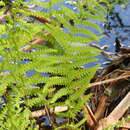mk
имиња во трошки


Der Sumpffarn oder Sumpf-Lappenfarn (Thelypteris palustris) ist eine Pflanzenart aus der Gattung Thelypteris innerhalb der Familie der Sumpffarngewächse (Thelypteridaceae).[1]
Der Sumpffarn wächst als ausdauernde krautige Pflanze und erreicht Wuchshöhen von 30 bis 80 Zentimetern. Das weit kriechende Rhizom ist bis 50 Zentimeter lang. Seine Blattwedel sind 15 bis 100 Zentimeter lang, am Grunde wenig verschmälert und zart. Die Sporen tragenden Wedel entfalten sich mehrere Wochen nach den sterilen Wedeln. Die Fiederchen sind schmal lineal ganzrandig (bis schwach gezähnelt), mit gelblichen Drüsen und weißlichen Haaren und mit zurückgerolltem Rand, sie haben keinen speziellen Duft.
Die Sori liegen zwischen Mittelrippe und Rand und sind später diesem genähert. Die Sporenreife liegt zwischen Juli und September.
Die Chromosomenzahl beträgt 2n = 70 oder 72.[2]
Der Sumpffarn ist ein Geophyt.
Das Verbreitungsgebiet des Sumpffarns erstreckt sich von Europa bis Vorderasien und Nordafrika, die etwas abweichende Sippe var. pubescens (G.Lawson) Fern. tritt in Ostasien und in Nordamerika auf, die in Europa heimische Sippe var. palustris findet man vor allem im temperierten Gebiet nordwärts bis Südschweden und Finnland, im subkontinentalen Bereich und in den Alpen in Höhenlagen bis zu 1200 Metern, im Mittelmeerraum ist sie selten.
Der Sumpffarn tritt in Mitteleuropa in lockeren Herden an beschatteten bis lichtreichen, doch absonnigen, frischen, kalkarmen, sauren, oft modrig-humosen Lehmböden auf. Er besiedelt meist zusammen mit anderen Farn-Arten vor allem montane Buchen- und Buchen-Tannen-Wälder, kommt aber auch in artenreichen Tannen-Fichten-Wäldern (Pyrolo-Abietetum) und in subalpinen Hochstaudenfluren vor. Er kommt vor allem in der Pflanzengesellschaft Carici elongatae-Alnetum des Verbands Alnion oder in Pflanzengesellschaften des Verbands Magnocaricion vor.[2]
Die ökologischen Zeigerwerte nach Landolt et al. 2010 sind in der Schweiz: Feuchtezahl F = 4+w (nass aber mäßig wechselnd), Lichtzahl L = 3 (halbschattig), Reaktionszahl R = 3 (schwach sauer bis neutral), Temperaturzahl T = 3+ (unter-montan und ober-kollin), Nährstoffzahl N = 3 (mäßig nährstoffarm bis mäßig nährstoffreich), Kontinentalitätszahl K = 3 (subozeanisch bis subkontinental).[3]
Die Erstveröffentlichung erfolgte 1753 unter dem Namen Acrostichum thelypteris durch Carl von Linné in Species Plantarum, Tomus II, S. 1071. In der Gattung Thelypteris konnte aber das Artepitheton palustris keine Verwendung finden. Das nächstälteste Epithet palustre kam von Polypodium palustre Salisb. in Prod. 403 (1796). Es war jedoch illegitim, da es einen älteren Namen einer anderen Art Polypodium palustre Burm. fil. (1768) schon gab. Heinrich Wilhelm Schott kombinierte beide zusammen als Thelypteris palustris Schott in Genera Filicum bei Tafel 10, 1834. Der Klammerautor "Salisb." soll also weggelassen werden, da es sich um ein illegitimes Epithet handelte.[1] Weitere Synonyme für Thelypteris palustris Schott sind: Aspidium thelypteris (L.) Sw., Dryopteris thelypteris (L.) A.Gray, Lastrea thelypteris (L.) Presl, Nephrodium thelypteris (L.) Stremp. 1822.
Je nach Autor gibt es etwa zwei Unterarten:
Der Sumpffarn oder Sumpf-Lappenfarn (Thelypteris palustris) ist eine Pflanzenart aus der Gattung Thelypteris innerhalb der Familie der Sumpffarngewächse (Thelypteridaceae).
Thelypteris palustris, the marsh fern,[3] or eastern marsh fern,[4] is a species of fern native to eastern North America and across Eurasia. It prefers to grow in marshy situations in full sun. The species epithet palustris is Latin for "of the marsh" and indicates its common habitat.[5] It is the only known host plant for Fagitana littera, the marsh fern moth.[6]
The following subspecies are accepted:[2]
Thelypteris palustris, the marsh fern, or eastern marsh fern, is a species of fern native to eastern North America and across Eurasia. It prefers to grow in marshy situations in full sun. The species epithet palustris is Latin for "of the marsh" and indicates its common habitat. It is the only known host plant for Fagitana littera, the marsh fern moth.
Thelypteris palustris, appelée en français fougère des marais, polystic des marais, polystic à bords roulés ou polystic des marécages est une espèce de fougère de la famille des Thelypteridaceae. On la trouve, comme son nom l'indique, dans les dépressions marécageuses, souvent associée à des aulnes. On en trouve aussi dans les jardins et les parcs.
Thelypteris palustris est une fougère glabre, à rhizome rampant, qui possède des frondes bipennées à long pétiole. Les lobes des pinnules sont entiers, très légèrement enroulés vers la face inférieure.
Les sores sont disposées sur la face inférieure, de part et d'autre de la nervure centrale.
Cette fougère vit dans des marécages et bois humides, souvent en zone tourbeuse.
Thelypteris palustris est une des plantes considérées comme caractéristiques de l'association Carici elongatae-Alnetum, c'est-à-dire des bois d'Alnus glutinosa de dépressions marécageuses, mésotrophes et méso-eutrophes[1].
Cette espèce a été aussi appelée Polystichum thelypteris Roth., Dryopteris thelypteris (L.) A.Gray, Nephrodium thelypteris (L.) Strempel et Lastrea thelypteris (L.) C.Presl.
La fougère des marais bénéficie de mesures de protection dans plusieurs régions de France : Alsace, Normandie, Champagne-Ardenne, Provence-Alpes-Côte d'Azur, Bourgogne, Limousin, Rhône-Alpes, Franche-Comté, Lorraine, Centre et Île-de-France[2].
Thelypteris palustris, appelée en français fougère des marais, polystic des marais, polystic à bords roulés ou polystic des marécages est une espèce de fougère de la famille des Thelypteridaceae. On la trouve, comme son nom l'indique, dans les dépressions marécageuses, souvent associée à des aulnes. On en trouve aussi dans les jardins et les parcs.